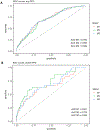Effects of Intra-operative Cardiopulmonary Variability On Post-operative Pulmonary Complications in Major Non-cardiac Surgery: A Retrospective Cohort Study
- PMID: 38488884
- PMCID: PMC11575736
- DOI: 10.1007/s10916-024-02050-6
Effects of Intra-operative Cardiopulmonary Variability On Post-operative Pulmonary Complications in Major Non-cardiac Surgery: A Retrospective Cohort Study
Abstract
Intraoperative cardiopulmonary variables are well-known predictors of postoperative pulmonary complications (PPC), traditionally quantified by median values over the duration of surgery. However, it is unknown whether cardiopulmonary instability, or wider intra-operative variability of the same metrics, is distinctly associated with PPC risk and severity. We leveraged a retrospective cohort of adults (n = 1202) undergoing major non-cardiothoracic surgery. We used multivariable logistic regression to evaluate the association of two outcomes (1)moderate-or-severe PPC and (2)any PPC with two sets of exposure variables- (a)variability of cardiopulmonary metrics (inter-quartile range, IQR) and (b)median intraoperative cardiopulmonary metrics. We compared predictive ability (receiver operating curve analysis, ROC) and parsimony (information criteria) of three models evaluating different aspects of the intra-operative cardiopulmonary metrics: Median-based: Median cardiopulmonary metrics alone, Variability-based: IQR of cardiopulmonary metrics alone, and Combined: Medians and IQR. Models controlled for peri-operative/surgical factors, demographics, and comorbidities. PPC occurred in 400(33%) of patients, and 91(8%) experienced moderate-or-severe PPC. Variability in multiple intra-operative cardiopulmonary metrics was independently associated with risk of moderate-or-severe, but not any, PPC. For moderate-or-severe PPC, the best-fit predictive model was the Variability-based model by both information criteria and ROC analysis (area under the curve, AUCVariability-based = 0.74 vs AUCMedian-based = 0.65, p = 0.0015; AUCVariability-based = 0.74 vs AUCCombined = 0.68, p = 0.012). For any PPC, the Median-based model yielded the best fit by information criteria. Predictive accuracy was marginally but not significantly higher for the Combined model (AUCCombined = 0.661) than for the Median-based (AUCMedian-based = 0.657, p = 0.60) or Variability-based (AUCVariability-based = 0.649, p = 0.29) models. Variability of cardiopulmonary metrics, distinct from median intra-operative values, is an important predictor of moderate-or-severe PPC.
Keywords: Intraoperative hemodynamic variability; Intraoperative respiratory variability; Lung protective ventilation; Postoperative pulmonary complications.
© 2024. The Author(s), under exclusive licence to Springer Science+Business Media, LLC, part of Springer Nature.
Conflict of interest statement
Figures

 , direct relationship;
, direct relationship;  , inverse relationship; -, no significant relationship
, inverse relationship; -, no significant relationship
References
-
- Miskovic A, Lumb AB. Postoperative pulmonary complications. Br J Anaesth. 2017;118:317–34. - PubMed
-
- Fernandez-Bustamante A, Frendl G, Sprung J, Kor DJ, Subramaniam B, Martinez Ruiz R, et al. Postoperative Pulmonary Complications, Early Mortality, and Hospital Stay Following Noncardiothoracic Surgery: A Multicenter Study by the Perioperative Research Network Investigators. JAMA Surg. 2017;152:157–66. - PMC - PubMed
-
- Canet J, Gallart L, Gomar C, Paluzie G, Vallès J, Castillo J, et al. Prediction of postoperative pulmonary complications in a population-based surgical cohort. Anesthesiology. 2010;113:1338–50. - PubMed
-
- Futier E, Constantin JM, Paugam-Burtz C, Pascal J, Eurin M, Neuschwander A, et al. A trial of intraoperative low-tidal-volume ventilation in abdominal surgery. N Engl J Med. 2013;369:428–37. - PubMed
MeSH terms
Grants and funding
LinkOut - more resources
Full Text Sources
Medical

